SNC1W: Earth and Space Science
1/69
There's no tags or description
Looks like no tags are added yet.
Name | Mastery | Learn | Test | Matching | Spaced |
|---|
No study sessions yet.
70 Terms
List the planets in order from the sun
Mercury, Venus, Earth, Mars, Jupiter, Saturn, Uranus, Neptune.
What are constellations?
The different patterns that stars are organized into.
What is the north star and what/why is it used?
Polaris is the last and brightest star in the constellation Ursa Minor. It has been used for navigation since it is positioned nearly directly above the North Pole, making it a reliable indicator of true north. It’s at a fixed point so it doesn’t move.
What is the universe?
Everything that exists including all matter, energy, planets, stars, galaxies, and the contents of space.
But space is mostly…
empty space
What is the sun’s mass?
2.0 × 10^30 kg
What causes celestial objects to orbit the sun?
The massive gravitational force that the sun exerts.
How does gravity work to create orbits?
It is thought that gravity in space is a warping of space-time. Similar to how if you place a large object on a tarp it will continue to spin around the object due to the curvature created. However, in space there is no friction so the spinning never stops.
What do planets do around the sun and what does that mean?
Planets revolve around the sun, which means they move in an orbit around the sun.
What do planets do on their own axes?
Rotate
1 revolution =
1 year
1 rotation =
1 day
What size star is our sun?
A medium-sized star.
What is the sun made of?
It is a mass of superheated gases, primarily hydrogen and helium.
What happens in the sun’s core and what does it produce?
Nuclear fusion occurs in the sun's core, where hydrogen atoms collide and fuse into helium, releasing vast amounts of energy. This produces an outward energy which combat the huge gravitation force that compresses the sun. When it runs out of hydrogen fuels the force of gravity will continue to push until the sun implodes.
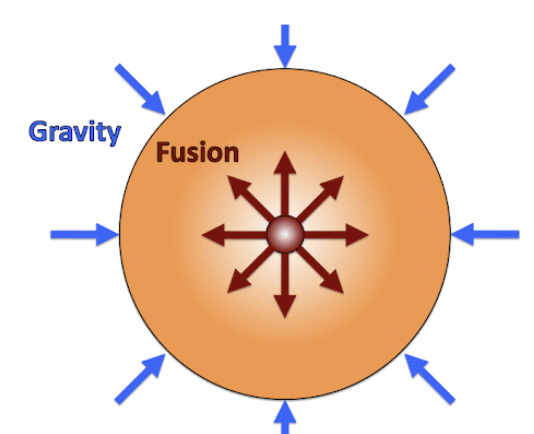
What is a galaxy?
A collection of billions of stars held together by gravity.
What galaxy is our solar system located in?
the Milky Way galaxy
Why don’t we use standard distance units in space?
Because the distance in space is so immense
What is an astronomical unit (AU)?
Equal to the distance between the Sun and the Earth (1AU = 150 million km)
Why do we use lightyears?
Because AUs become to small once we leave our solar system.
What is a lightyear?
The distance that light travels in one year (1 light year = 9.5 x ^ 12 km)
What is the Kuiper Belt and what is inside of it? (distance, shape, composed of, inside)
4.5 billion km away from the sun, A disc-shaped group of millions of small objects orbiting the Sun which is composed of fragments of material called Trans Neptunian Objects leftover from the formation of our solar system over 4.6 billion years ago.
Pluto (estimated diameter, classification and why)
Made of rock and ice, with an estimated diameter of 2300 km.
Referred to as a dwarf planet after being demoted int 2006 for sharing an orbit with its larger moon Eris.
The Oort Cloud
Located at the farthest reaches of the Sun’s gravitational influence (2000 - 100 000 AU from the Sun!) possibly contains objects such as comets.
Comets
Originate in the Kuiper Belt and Oort cloud. cosmic snowballs about the size of a small town that are composed of gas, rock, and ice that orbit the sun.
Why do comets have a tail and how big is it?
Their dusty, gaseous tails stretch away from the sun for millions of km. These tails form as they get close to the sun (and the sun’s massive radiant energy) and their ice melts releasing gas and dust into space. This gas and dust form a cloud around the comet called the coma. The Sun's heat and radiation (air) then push the dust and gas away from the Sun, forming the comet's long tail.
What are asteroids?
Non-spherical object believed to be debris leftover from the formation of the solar system. They orbit the sun in a band called that Asteroid Belt that is located between Mars and Jupiter. size from tiny grains of sand, to about 500 km wide. They can even have their own moons.
Meteoroids
Pieces of rock (broken away from asteroids) moving through space.
Meteors
Meteoroids that have collided with Earth’s atmosphere, and have burned up, as a result of the friction.
Sometimes referred to as shooting stars
Meteorites
Meteoroids that survive the impact with the atmosphere and reach the ground
Explain how parallax helps calculate distance
Since distance in space is large in space we need a different method of measureing. Parallax is the apparent change in position of an object when viewed from two different places.
Astronomers use it to measure how far away nearby stars are:
As Earth orbits the Sun, our view of a nearby star changes.
This makes the star appear to shift slightly against the background of more distant stars.
The angle of this shift is called the parallax angle.
Using this angle and the distance Earth moved, scientists use trigonometry to calculate how far away the star is.
Smaller shift = farther star
Bigger shift = closer star
What is the difference between a planet and a star?
Planets reflect the light from an external source and orbit stars whereas stars produce their own light and heat through nuclear fusion.
What is Earth’s rotational period?
24 hours
What is Earth’s revolutional period?
365 days
What is the shape of Earth’s orbit?
Elliptical.
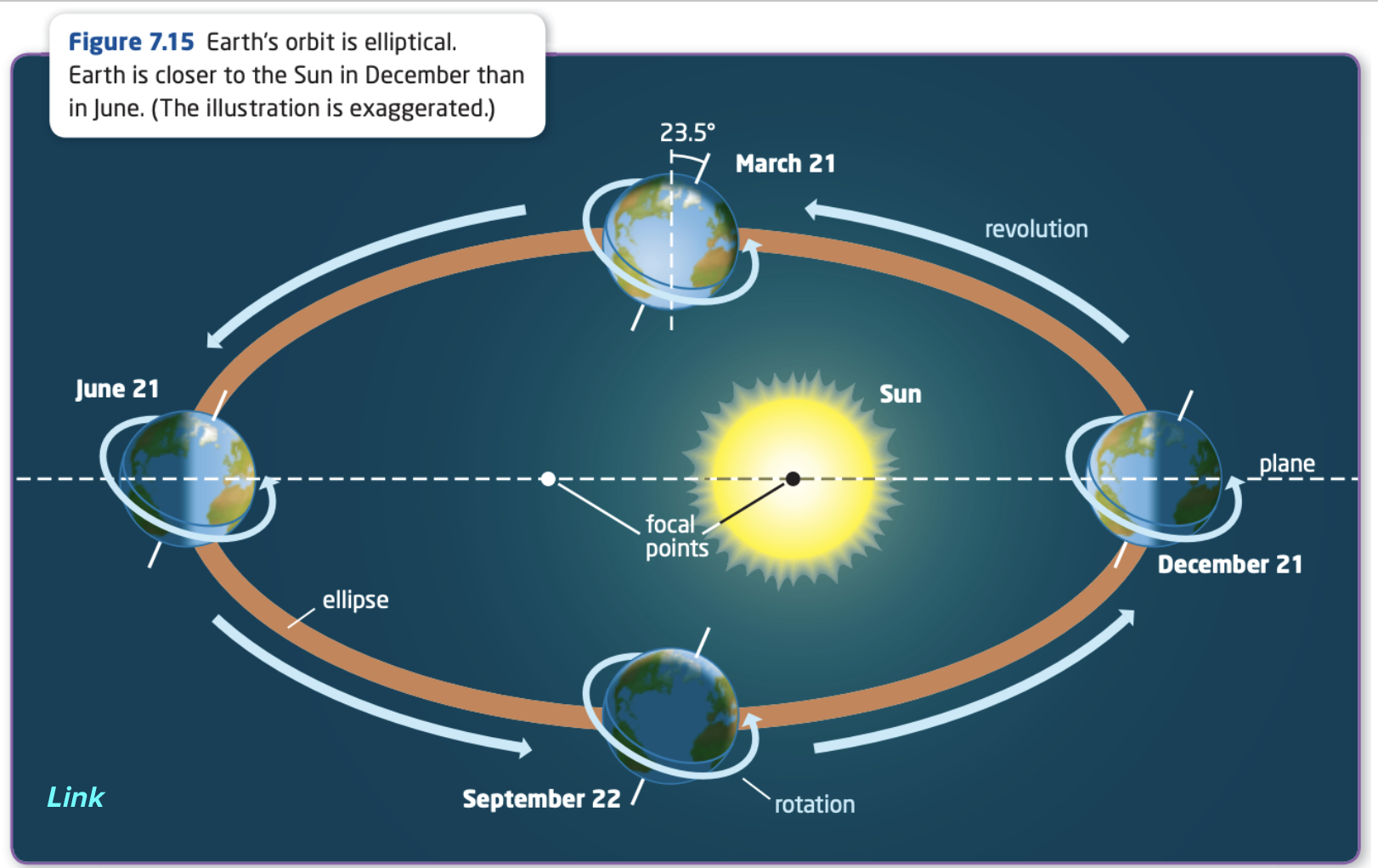
What is the tilt of Earth’s axis of rotation?
23.5º
Explain how Earth’s revolution and axial tilt, together cause seasons
Since the Earth is tilted, as it revolve around the sound different parts of the earth receive varying amounts of sunlight through the year. In the summer, one hemisphere is tilted towards the sun causing it to receiving more direct sun light. The other hemisphere is tilted away from the sun cause the sunlight to be more spread out and less direct, resulting in winter.
The Moon’s Motion
Our satellite, the moon, takes 29.5 days to make a complete orbit.
The moon also takes 29.5 days to rotate once itself. This is why we only ever see one side of the moon.
What is the definition of the phases of the moon?
The different ways the Moon appears from Earth as it orbits us, due to changing angles of illumination by the Sun. Essentially the different amounts of illumination you can see through the month.
What are the phases of the moon?
NCQGF
New Moon, Waxing Crescent, 1st Quarter, Waxing Gibbous, full, Waning Gibbous, 3rd Quarter, Waning Crescent
What is an eclipse and what are the two types?
When one celestial body passes in front of another as seen from Earth. Lunar and solar.
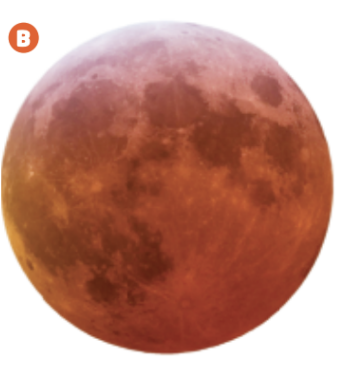
What is a lunar eclipse?
Occurs when the moon passes through the umbra portion of Earth’s shadow, so that Earth is directly between the Sun and the Moon. There are 2 lunar eclipses per year, and they are safe to watch.
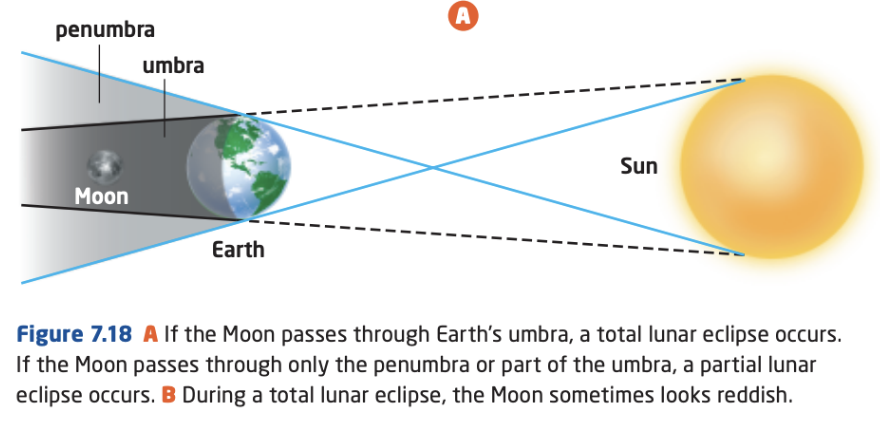
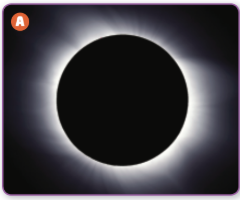
What is a solar eclipse?
Occurs when the Moon is directly between the Sun and Earth. Also occur twice per year but only during a New Moon.
Because the umbra portion of the shadow of the Moon on Earth is small, you must be in a very specific place on Earth’s surface to see a full solar eclipse.
It is not safe to watch a solar eclipse when any portion of the Sun is still visible.
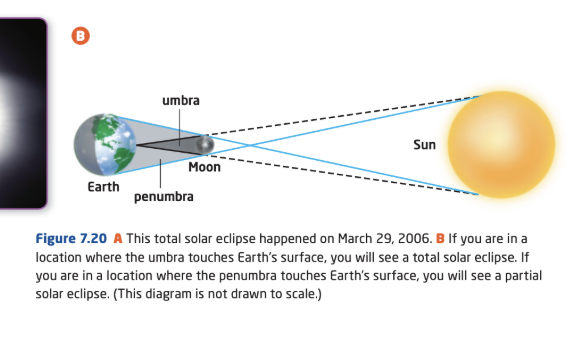
How are tides made?
The gravitational force between the Earth and Moon creates the tides.
The tides are a bulging of our oceans. The solid portions of Earth don’t bulge because they are solid vs fluid.
As the Earth rotates on its axis, it moves this “bulged” water.
When a specific location on Earth is in the middle of the bulge that is high tide, when it is 90o from this bulge that is low tide.
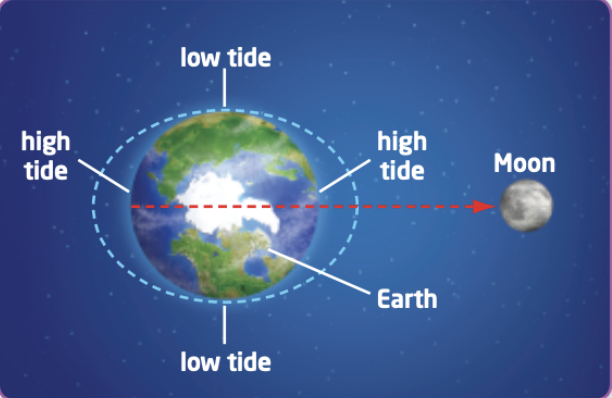
What is a star?
A giant fusion reaction.
What is nuclear fusion?
Nuclear fusion involves light atomic nuclei fusing to form heavy atomic nuclei on a massive scale! This process releases a lot of energy.
What is plasma?
Plasma is superheated, glowing gas that’s be created through heating a gas until it has so much energy that the electrons in the atoms of the gas break away from their orbits. This leaves behind a soup of charged nuclei and free electron.
What would happen if you touched plasma?
Severe burns or a vaporization of tissue
How does nuclear fusion work?
Under intense pressure and traveling at light speeds, isotopes of hydrogen slam into one another resulting in fusion and the formation of helium.
A neutron is lost in the process, and energy is released in the form of heat and light.
Why are some stars brighter than others?
Some stars are brighter than others because they are emitting more light, or because they are closer to us. Or both!
Why is polaris (the North star) so bright?
Because it’s a super giant
Luminosity
A measure of the total amount of radiant energy a star emits per second. Measured in reference to our sun.
What colour of stars is the hottest? The coolest?
Blue stars are the hottest, red stars are the coolest.
How are stars measured?
Using solar mass in relationship to our sun which is 1 solar mass.
What effects a star’s brightness?
A star looks brighter if it is:
Bigger (more surface to shine from)
Hotter (gives off more light)
Closer (light has less distance to travel)
What are our Sun’s characteristics?
It's a medium-sized, yellow star.
Surface temp: about 5,500°C.
Made of hot gases, mostly hydrogen and helium.
It’s the closest star to Earth and gives us light and heat.
Summarize what will eventually happen to our sun
The Sun is an intermediate star so it will live for about 10 billion years total.
Right now, it’s halfway through its life (about 4.6 billion years old).
Later, it will grow bigger and into a red giant
Then it will shed its layers and create a planetary nebula
It will lose mass as it burns fuel.
In the end, it will shrink into a white dwarf
What does the Hertzsprung-Russell diagram plot on its two axes?
Temperature and Luminosity
What is the definition of, the lifespan, and the fate of a low-mass star?
Less mass than the Sun (less than 1 solar mass), consume their hydrogen slowly (over 100 billion years), red giant, planetary nebula, end up as a white dwarfs, and eventually black dwarfs
What is the definition of, the lifespan, and the fate of a intermediate-mass star?
A star that has a mass between 1-12.
They consume their hydrogen in about 10 billion years. They become red giants, planetary nebula, and then a white dwarf.
What is the definition of, the lifespan, and the fate of a high-mass star?
>12 solar masses. They die quickly and violently when their core heats up to super-high temps, in a red supergiant he star collapses (because iron cannot release energy through fusion). Then turns into a supernova before turning into a black hole or neutron star.
Neutron Stars
A star that starts out as having 12-15 solar masses will shrink to approximately 20 km in diameter as it dies.
Because there is so much mass squeezed into such a small space, electrons fuse into protons. It is essentially a star so dense that only neutrons can exist in its core.
What is a white dwarf?
A small, dim, hot star that no longer produces energy.
What is a black hole?
Occurs in stars with a solar mass greater than 25. The remnant of the supernova explosion is so massive that nothing can compete with the crushing force of gravity. So it forms a tiny path of space that has no volume, but has mass. This creates a gravitation force so strong the nothing can escape it, not even light.
What is a red super giant?
a very large, bright, and cool star in the final stages of its life. This is where iron is formed before the star becomes a supernova.
What is a stellar nebula?
A cloud of gas and dust in space where stars are born.
What are the properties of the stars located in the main sequence?
These make up 90% of what we see in the night sky. They include massive stars, intermediate-mass stars and low-mass stars.
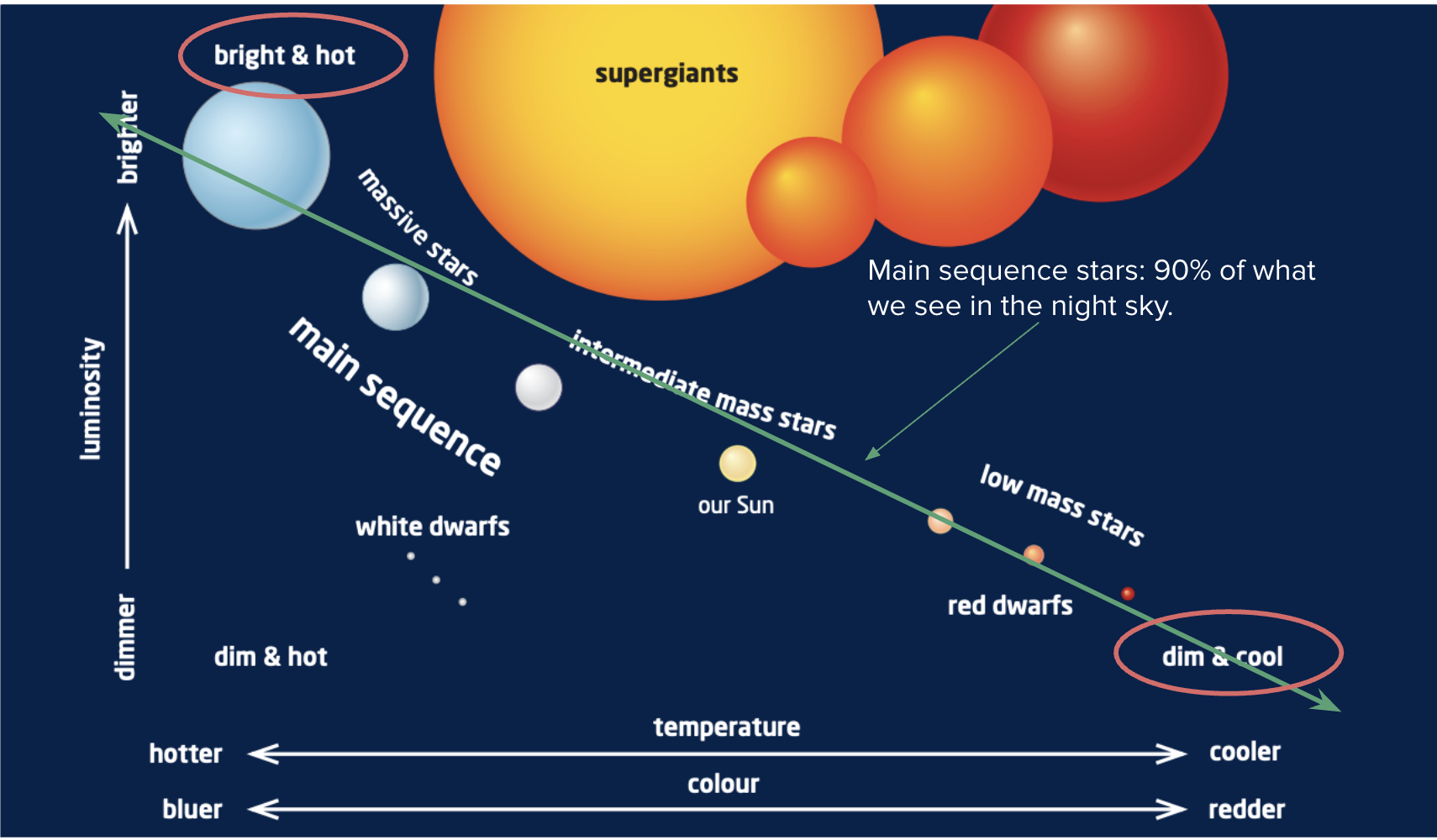
What is a planetary nebula?
As the red giant runs out of fuel, the core shrinks and heats up, while the outer layers become unstable.
Pulses of energy push the outer gas layers away into space.
This creates a planetary nebula, leaving behind a white dwarf.
What is a red giant?
A red giant is a star that’s near the end of its life.
It forms when a medium star (like the Sun) runs out of hydrogen in its core.
The core shrinks, but the outer layers expand and cool, making the star look big and red.
How did early civilizations use the sky?
Timekeeping: Used the Sun, Moon, and stars to track days, months, and seasons.
Agriculture: Knew when to plant or harvest based on the stars (e.g., rising of Sirius = Nile flood for Egyptians).
Spiritual Belief: Saw sky events (eclipses, planets) as messages from gods or used stars in myths.
Mesopotamians, Mayans, Egyptians, Chinese, Indigenous peoples, and others studied the sky in their own ways